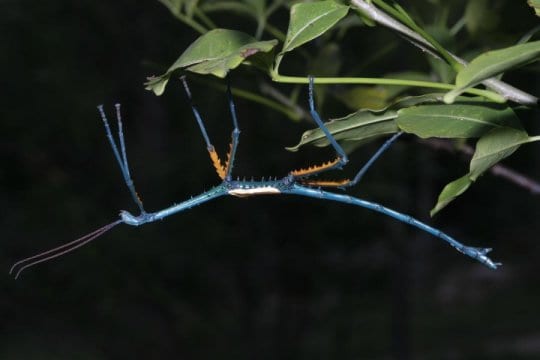Table of Contents
Stick insects could be considered as nature’s masters of camouflage. But can they actually change color?
A simple answer would be to say that stick insects cannot change color, but it is neither as simple nor as straightforward as that. Most stick insects are indeed unable to change their color at will, but there are some species able to do so gradually, blending in perfectly with their natural habitat.
For more advice and information on keeping and looking after stick insects, check out my ebook on Amazon click here
(opens in a new tab).

The True Colors of a Stick Insects
Being delicate nocturnal creatures, stick insects are really good at camouflaging. They have an amazing ability that allows them to blend perfectly with their surroundings, making them almost invisible to any predators. Stick insects make use of various clever disguise techniques, though intentional change of color is not one of them. The natural color of a stick insect will, for the most part, match the natural color of its immediate surroundings or its everyday habitat. For instance, stick insects that live predominantly on trees will resemble twigs and small branches and be mostly brown-grey in color, much like the natural bark color of the trees they inhabit.
are really good at camouflaging. They have an amazing ability that allows them to blend perfectly with their surroundings, making them almost invisible to any predators. Stick insects make use of various clever disguise techniques, though intentional change of color is not one of them. The natural color of a stick insect will, for the most part, match the natural color of its immediate surroundings or its everyday habitat. For instance, stick insects that live predominantly on trees will resemble twigs and small branches and be mostly brown-grey in color, much like the natural bark color of the trees they inhabit.
Those stick insect species that live higher up in trees where the foliage is, or else live on leafy green plants lower down, are obviously green colored in order to blend in with the natural greenish color of leaves. As always, there are exceptions to the rule and some stick insects are brightly colored or display colorful stripes contrasting to their otherwise inconspicuous color scheme.
Color Changes in Stick Insects
So now you know that most stick insects adopt the natural color of their surroundings, whether that be green, brown, or something else in order to make them hard to spot by predators. Having said that though, most stick insect species are incapable of changing their color instantly like, for example, a chameleon.
There is though one species of stick insect which is able to slightly change its color, and that is the Indian stick insect (Carausius morosus). A shift in surroundings may also trigger a color change in some species of stick bug like the California timema (Timema californica) and Bostra scabrinota. Obviously, the change of color in the stick insect will match its new surroundings in order to keep it camouflaged from predators.
(Carausius morosus). A shift in surroundings may also trigger a color change in some species of stick bug like the California timema (Timema californica) and Bostra scabrinota. Obviously, the change of color in the stick insect will match its new surroundings in order to keep it camouflaged from predators.
Color Defense Mechanisms
Although stick insects cannot instantly change their outer color to blend with new or unexpected surroundings, these amazing creatures make excellent use of color defense mechanisms. Many stick insects have brightly colored wings tucked along their body which are deployed as means of distraction and evasion when facing a predator. The stick insect spreads its brightly colored wings and startles the incoming predator, giving itself enough time to evade predation. The predator is usually startled and confused by the sudden color burst, unable to reacquire their prey.
Stick insects are indeed no chameleons, but their use of color as means of survival and defense is absolutely fascinating. Their disguised appearance is made even more obscure by their natural colors as well as their ability to stay still for hours on end, or gently rock back and forth similar to leaves swaying in the wind.
Currently there are over three thousand known species of stick insects that we know about. However, new species being discovered and documented all the time, so it is not implausible that the existence and discovery of a true chameleon-like stick insect is just a matter of time.

